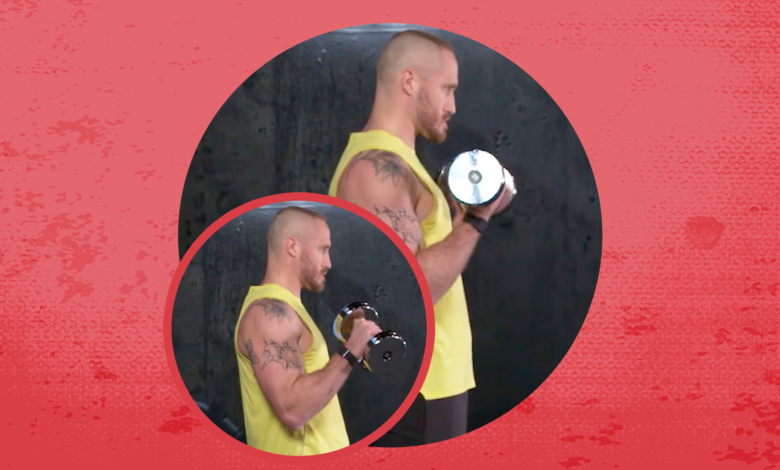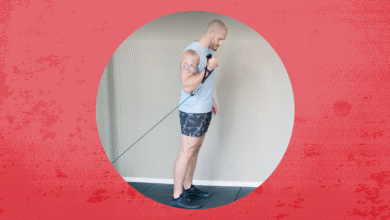The Zottman Curl Blows Up Your Biceps and Forearms

BICEPS CURLS ARE a top-tier muscleman exercise. Step foot into any self-respecting gym, head to the free weight floor, and watch for just a few minutes. Inevitably, someone will grab a set of dumbbells and get to pumping. But doing the same movement over and over gets stale—and there are different factors lifters can tweak to level-up their arm day workouts. One reliable way that pump-chasers can put a new spin on their curl session is by taking on an underrated variation that will allow you to pull double-duty to train the forearms, too. We’re talking about the Zottman curl.
The Zottman curl isn’t some hyper-technical, new-age innovation, either. The exercise has been around since the 19th century, when old-time strongman George Zottman developed it to target the biceps, brachialis, and forearms in one go.
Once you put it into practice, you’ll reap even more gains out of your curl workout. The catch: you’ll have to be patient and focus on all phases of the lift. You should already do that with every exercise, but it’s even more important with the Zottman curl, which has a different orientation for the concentric and eccentric parts of the movement.
To master the subtleties of the exercise, take notes as Men’s Health fitness director Ebenezer Samuel, C.S.C.S. and senior editor Brett Williams, NASM-CPT reintroduce you to this classic double-powered arm-builder.
How to Do the Zottman Curl
- Stand holding a pair of dumbbells in a neutral position. Squeeze your shoulder blades and glutes while using your abs to drive your ribcage down and closed.
- Curl the dumbbells up, rotating your palms and turning your pinkies upward, squeezing your biceps at the top.
- Pause for a count, then twist the dumbbells forward so your palms are facing out, rotating only at the forearms. Fight to keep your elbows still as you move your wrists.
- Lower the weights back down to the starting position slowly, taking two or three seconds.


Benefits of the Zottman Curl
Unlike most other curls, which only directly target the biceps muscles (and in some cases like the hammer curl, the brachialis), the Zottman curl is designed to engage your forearms as well. Direct forearm training is too often ignored in standard workout splits, which is unfortunate since the muscles are essential for proportionately-developed arms and because strong forearms are the key to a strong grip.
To target your forearms, you’ll need to turn your palms and emphasize the eccentric (lowering) portion of the lift. Once you flip your palms, you’ll be in the right spot. Along with giving your forearms some much-needed attention, this focus will also help you to slow down for the eccentric phase, a principle you should apply to other exercises to keep yourself from rushing, too.
You also make this a true biceps isolation exercise, since you’ll focus on pausing and emphasizing the squeeze at the top of the lift. Don’t skimp on this aspect of the exercise just because you’ll also be training your forearms.
Muscles Worked By the Zottman Curl
Like other curls, the Zottman is a great way to target your biceps muscles. But you’ll also hit your forearms—more specifically, your brachioradialis muscle. That will come once you rotate the weights at the top of the first part of the movement, then will be emphasized with the slow eccentric descent.
Common Zottman Curl Mistakes
The most common mistake here is moving too fast. “If people are going to curl up, they’re going to twist quickly and they’re going to lower down way too quickly, then you lose that eccentric effect, you don’t get the most out of curl,” Samuel says.
Make sure that you move slowly with each step—lift and supinate, squeeze your biceps at the top, rotate slowly, then lower on a two to three second count. Never just drop the weight. If you can’t control your descent, use lighter dumbbells.
How to Add the Zottman Curl to Your Workouts
Since this is a forearm-focused movement, don’t try and lift heavy with this accessory move. Grab weights that are 10 to 15 pounds less than you normally would in a curl for about eight to 10 reps.
“You don’t want to have to rush through a bunch of reps,” Samuel says. “I’d rather you get eight to 10 good reps and really appreciate that eccentric—feel it in your forearms and feel it in your biceps.”
Want to master even more moves? Check out our entire Form Check series.



